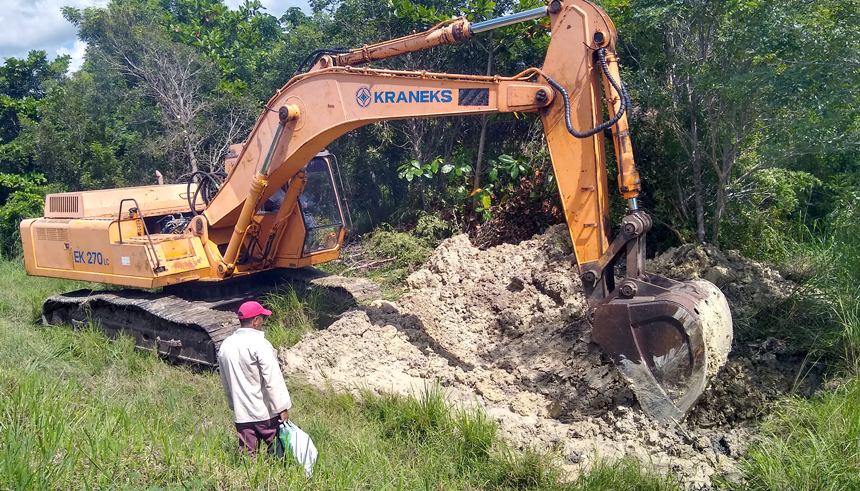 Work on the Piedra Hueca pipeline to eliminate leaks. |
The water supply crisis that the city of Las Tunas has been facing for months is close to diminishing with the investment made by the Provincial Delegation of the National Institute of Hydraulic Resources (INRH) to ready a completely new pipeline from the Piedra Hueca pumping station, belonging to La Cana underground basin, to the capital of the territory.
Las Tunas, Cuba.- Workers of the construction company of that entity defiance the rain, the sun, and the bite of insects during long and intense hours, in their desire to complete this mission to relieve the critical situation.
In the middle of an irregular terrain and the mud caused by the intense rains of these days, the backhoes seem to have no end digging into the ditches with the water that constantly gushes out, in the effort to reach the leaks in some sections.
Such defects were caused by incorrect welding for plastics, which were not done well at the joining points, precisely, it is alleged, due to the humidity of those fields surrounded by marabou and weeds, which complicates the successful development of the convoluted process and the integrity of the terminations.
However, the brigade, with fatigue on its back, returns again and again to its exhausting task, while the INRH delegate in the province, Mirtha García Rojas, on-site, feels optimistic and recognizes the work carried out to improve this service in the capital of Las Tunas.
"Currently, we are carrying out work that is within the Institute's investment plan in the province, as part of a loan to carry out the rehabilitation of the civil works, although it has not yet been finalized. We are working to ready the pipelines, of which four have already been installed from the six wells to the main cistern, plus another from the central station to the pressure breaker, with around eight kilometers,” she pointed out.
“After the connections were made, in the testing phase, around five breaks were detected in the welding of the joints. These leaks are already being sealed, as part of an excavation process to discover the stretches where they are. These actions will conclude in the coming days to carry out the tests again and eliminate the current impact on the service to a large part of the main municipality."
García Rojas assured that three pumping equipment are ready, which bring water from the wells to the cistern, where there is another with the capacity to deliver between 130 to 150 liters per second. Also, the 800-millimeter diameter pipeline is completed, from the pressure breaker to these city properties, with around 12 kilometers; a costly investment that has not been finished because there has been a lack of supplies to completely replace it.
“Both the old pipes from the wells and the pipeline to the city were very deteriorated, they had been in operation for around 50 years, in addition to the indiscipline of many people in rural areas who broke sections to connect and guarantee the water for their agricultural and livestock work. "This threatened the pressure of the liquid on its way to Las Tunas," said the directive.
The pipelines that will soon be ready are of high quality and were designed for more than half a century of exploitation.
Although hydraulic work will bring relief to many homes, it does not mean the happy closure of a panorama that becomes desperate in different areas since even the El Rincón system, the main source of supply for this city, works with only two electric pumps. The core of the current crisis resides in the availability and breakdowns of these pumping equipment, which has nothing to do with low levels of storage in reservoirs.